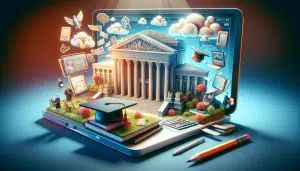Remote Learning Innovations That Might Surprise You
Lily Carter October 26, 2025
Explore how remote learning is transforming education and society. This insightful look at surprising innovations, accessibility, digital divide solutions, and future trends addresses remote teaching, virtual classrooms, and equitable technology in schools.
The Evolution of Remote Learning
Remote learning, once considered a temporary fix, now shapes educational practice worldwide. With advances in technology, more institutions have adopted online platforms, making remote education accessible to learners regardless of location. This shift is not simply about moving lessons online; it’s a dramatic rethinking of educational delivery, interaction, and accessibility. Many educators see this as an opportunity to reach students who previously struggled with traditional classroom models, creating more flexible learning environments for students of varying backgrounds. Digital platforms can blend synchronous and asynchronous experiences, offering personalized learning paths for those who thrive outside the typical school day.
Innovative teaching methods have surfaced alongside remote learning’s rise. Traditional lectures now give way to interactive virtual classrooms, online discussion forums, and multimedia coursework. Video conferencing tools allow real-time collaborations between students and teachers across continents. This fosters not only academic growth but also intercultural exchange, as learners connect globally. Furthermore, adaptive learning algorithms are increasingly used to customize content that matches each student’s learning speed and style, resulting in higher engagement and improved comprehension compared to one-size-fits-all approaches.
These advancements, however, bring significant challenges and opportunities for schools and families. Integrating remote education requires new skills for teachers, from digital literacy to online engagement strategies. Likewise, schools must provide sufficient support for infrastructure and cybersecurity, ensuring safe learning environments (Source: https://www.ed.gov/remote-learning). As both students and instructors adapt to technology, a period of adjustment usually brings both excitement and anxiety. Yet, for many, the value of accessible education and the potential for lifelong learning far outweigh initial hurdles.
Tackling the Digital Divide in Education
One urgent concern with remote learning is the digital divide—the gap between those with reliable internet access and those without. For many students, home internet is not a given. Equitable technology in schools aims to address these disparities by providing devices and subsidizing connectivity for families in need. Programs led by local governments, school districts, and nonprofits focus on bridging accessibility gaps by delivering laptops or tablets to underserved learners. These efforts are crucial for ensuring that remote learning does not reinforce existing social inequalities but instead acts as a bridge to opportunity for all students.
Community partnerships are essential in expanding the digital ecosystem. Some organizations provide Wi-Fi hotspots. Libraries and public centers are repurposed as safe study spaces with supervised internet access. Teachers also adapt by designing assignments that do not rely exclusively on online resources, making learning possible for those with limited digital tools. Supports like hybrid workbooks and mailed instructional packets offer offline alternatives, ensuring everyone has a fair chance to succeed in a remote environment (Source: https://digitalpromise.org/education-equity-digital-divide).
Still, lasting solutions require broad policy and investment. Broadband infrastructure in rural and low-income urban areas is a critical focus for many countries. Government legislation, coupled with corporate-volunteer initiatives, helps fund network upgrades and subsidized plans. This major societal challenge is a high priority, as equity in digital education means empowering all families to participate in online learning. Direct feedback from parents and students is increasingly used to drive community-informed tech strategies, reinforcing the importance of local voices in solving access inequalities.
Innovative Teaching and Engagement Strategies
With the shift to remote education, innovative strategies keep students engaged. Gamification, for example, turns lessons into interactive challenges—earning badges, points, or certificates for participation. Successful virtual classrooms employ digital whiteboards, breakout rooms, and real-time polls to spark creativity. These tools help simulate the dynamic energy of in-person learning while bringing new dimensions to subjects through animations and simulations. Teachers now experiment with storytelling, project-based assignments, and peer-led discussions to maintain social and cognitive connections among remote participants.
Remote learning also fosters student independence and self-regulation. Many platforms provide dashboards where students set goals and track progress, encouraging greater agency and ownership of academic growth. Social learning networks create student communities that exchange ideas and provide peer mentoring, building collaboration skills crucial for lifelong success. Instructors use data analytics from these platforms to tailor guidance, offer personalized support, and intervene early when learners need extra help.
Not all students thrive instantly in virtual environments. Barriers such as screen fatigue, lack of motivation, or unfamiliar technology can impede learning. Creative educators turn to varied content formats—mixing video, audio, text, and interactive quizzes—to suit different learning styles. Mindfulness exercises, short brain breaks, and guided reflection sessions are woven into the remote curriculum, emphasizing well-being alongside academics. By routinely surveying students about their experiences, instructors fine-tune methods to keep engagement high (Source: https://www.edutopia.org/article/strategies-remote-engagement).
Accessibility and Inclusive Remote Learning Practices
Remote learning platforms must be designed with accessibility in mind. For students with disabilities, features like closed captioning, screen reader compatibility, and text-to-speech tools are essential. Thoughtful digital content addresses visual and hearing impairments, making lessons possible for a broader audience. Additionally, adaptive technology supports learners with dyslexia and other conditions, using color filters and customizable text layouts. Many schools collaborate with experts to audit and improve accessibility, ensuring remote learning environments comply with inclusive education standards.
Language barriers are tackled with embedded translation services and multilingual content streams. Digital resources are often available in multiple languages, enabling families from diverse backgrounds to participate more fully in children’s education. Tutorials for both parents and students about platform use are now standard, with tech support lines specifically for first-time users. Schools emphasize clear, simple instructions and use video demonstrations to minimize confusion (Source: https://www.cast.org/inclusive-remote-learning).
Safari readers and simplified display settings benefit students with attention disorders or those easily distracted by cluttered screens. Flexible scheduling accommodates students with differing home responsibilities or chronic health issues. When implemented thoughtfully, remote learning promotes a culture of accessibility and inclusion. This shift holds promise for lasting improvements in not only remote but also traditional classroom practices, making educational environments more responsive to every individual’s needs.
The Role of Parents and Guardians in Remote Learning
Parents and guardians have become pivotal partners in remote education. Their involvement often directly influences student motivation and academic performance. Many households establish daily routines, designate learning spaces, and create calendars to keep students organized amid competing home responsibilities. Open channels of communication with teachers, such as regular video conferences and message platforms, enable quick problem-solving and emotional support for learners experiencing remote fatigue or frustration.
Support for families is increasingly a focus for schools and policy initiatives. Resources—such as online workshops for digital literacy, community tech helplines, and parent forums—address common concerns, like managing screen time or troubleshooting devices. Some regions employ family liaisons or home-visiting educators to support those adjusting to virtual schooling. These collaborations foster a sense of community, reducing the sense of isolation and providing crucial mentorship for parents new to digital learning environments.
Parental well-being is equally prioritized. Many education agencies share strategies for self-care, digital balance, and mental health awareness, both for adults and their children. School counselors and psychologists frequently host webinars on managing stress, establishing healthy digital habits, and nurturing resilience in uncertain times. By recognizing parents as co-educators, remote learning initiatives ultimately build stronger, more resilient educational communities (Source: https://www.naset.org/remote-parent-support).
Future Trends and Opportunities in Remote Education
Looking forward, remote learning is set to drive several major changes in education. Hybrid models that blend on-site and online instruction cater to a broader spectrum of student needs and learning preferences. Advances in artificial intelligence power personalized content, automate grading, and offer targeted feedback, freeing educators to focus on mentorship. Virtual reality classrooms simulate labs and field trips, bringing immersive experiences to students who might otherwise lack access (Source: https://ed.stanford.edu/news/future-of-remote-learning).
Continual innovation in remote learning platforms is expanding educational options for adult learners, professionals, and lifelong students. Short courses, micro-credentials, and certification programs are ever more common, letting people upskill at their own pace. Supportive networks and knowledge-sharing communities are being built around these programs, driving collaboration across industries and disciplines. As these developments accelerate, resilience and adaptability become core skills for both educators and students.
None of these innovations can succeed without a foundation of equitable access and intentional design. Policymakers, technology providers, and communities must collaborate to ensure digital education remains inclusive. As remote learning continues to evolve, its principles of flexibility, creativity, and learner-centered design are likely to transform education at every level. The coming years hold possibilities for more dynamic, responsive, and accessible schools for everyone.
References
1. U.S. Department of Education. (n.d.). Remote Learning. Retrieved from https://www.ed.gov/remote-learning
2. Digital Promise. (n.d.). Closing the Digital Equity Gap. Retrieved from https://digitalpromise.org/education-equity-digital-divide
3. Edutopia. (n.d.). Remote Engagement Strategies. Retrieved from https://www.edutopia.org/article/strategies-remote-engagement
4. CAST. (n.d.). Inclusive Remote Learning Practices. Retrieved from https://www.cast.org/inclusive-remote-learning
5. National Association of Special Education Teachers. (n.d.). Parent Support for Remote Learning. Retrieved from https://www.naset.org/remote-parent-support
6. Stanford Graduate School of Education. (n.d.). Future of Remote Learning. Retrieved from https://ed.stanford.edu/news/future-of-remote-learning







